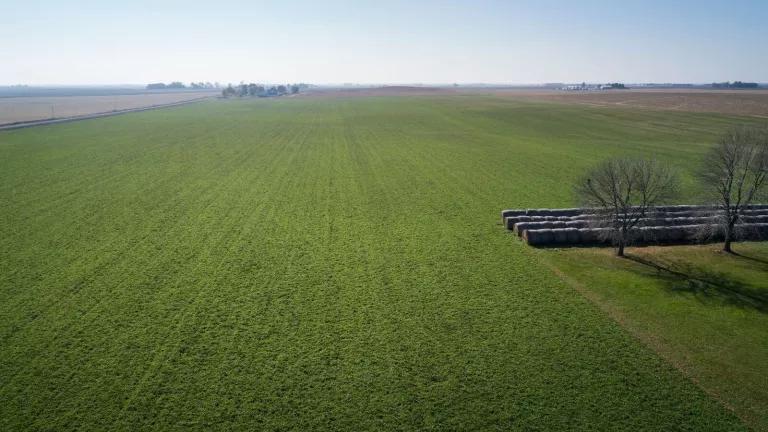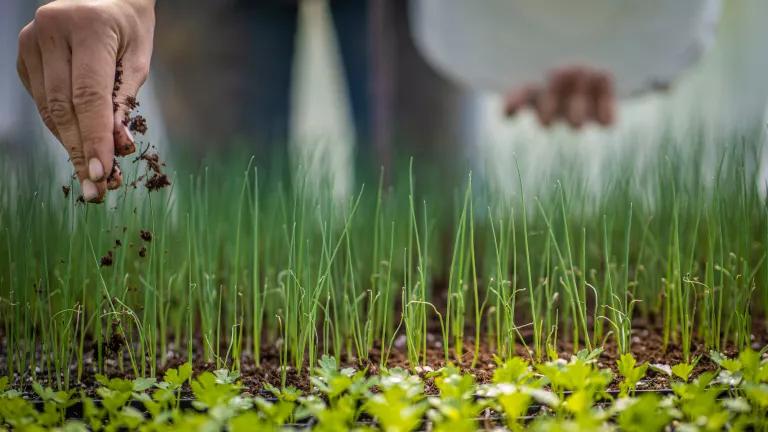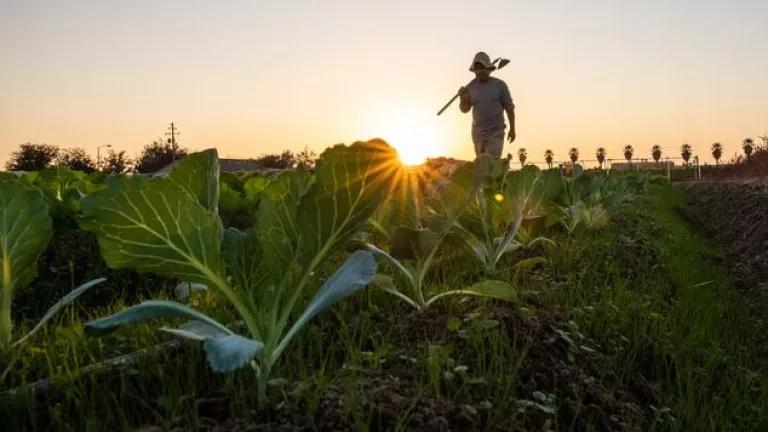What Climate Adaptation Looks Like: Improving Soil Health

This post is part of an NRDC series on climate adaptation. You can find the previous post here.
“Everyone who eats needs to understand that this generation of farmers is facing unprecedented change.” – Laura Legnick, Cultivating Resilience, LLC
When I think of farmers and climate adaptation, I remember Dr. Laura Legnick’s words, spoken to an audience of growers and sustainable food enthusiasts at the Southern Sustainable Agriculture Working Group Conference in Little Rock, Arkansas, in January of 2020. Dr. Legnick emphasized the word “unprecedented.” And I can’t forget what she said next to the younger generation of farmers in the room: that if they thought things were much harder than expected, that’s because they are. And to give yourselves a break.
Over the past few years, my colleagues and I have been working with and listening to farmers around the country, and what we hear is that times are hard—edging into Dust Bowl levels of hard. One year, you can be hit by drought, the next by flood. Back in January, few anticipated that the COVID crisis would be causing market disruptions for farmers across the country who relied on restaurants, schools, and farmers markets for their primary sales. For young farmers, it’s harder than ever to make it in today’s agricultural marketplace—–and climate change is making matters worse.
Climate change is not just a threat of harm to come in the distant future: it’s happening right now for American farmers. Farming has always been a risky business, and farmers have always had to deal with extreme weather. But climate change is fueling even more frequent and severe weather extremes, and some farms will not survive tough years without climate adaptation.
NRDC’s Climate Ready Soil report summarized the major potential effects of climate change on agricultural crops, including:
- Increased water demand from the crop in warmer temperatures, leading to lower productivity;
- Increased demand for irrigation due to less rain in some climates;
- Increased soil erosion leading to decreased productivity from heavy rain in other climates; and
- Increased pest and weed presence contributing to crop loss.
How are farmers adjusting to these changes? Regenerative farmers across the country have told us they are rising to the challenge of adaptation by diversifying their crops and farm income, modifying planting times, selecting plant and animal species suited to local climates, and modifying irrigation systems for efficiency. Above all, the most common and effective strategy for farmers adapting to climate change is improving soil health.
So many producers have told me that it all starts with the soil. Healthy soil is alive, with billions of microorganisms working together in harmony to cycle nutrients and create a healthy environment for growing plants and natural resilience to protect against pests and diseases. Healthy soil has plenty of organic matter and a good structure for retaining thousands of gallons of water—reducing runoff in times of flood and preserving more water for times of drought. Living roots in healthy soil hold the topsoil in place, preventing it from eroding during heavy rains.
So how do farmers improve soil health? We find that the basic principles are:
- Minimize soil disturbance (try not to till);
- Keep living roots in the soil;
- Promote diversity (diverse crops and rotations);
- Reduced use of synthetic chemical inputs; and
- Incorporate animals to mimic natural ecosystems (grazing and harmony with wild animals).
Cover crops are one key practice that gets many farmers on a path toward improved soil health. At NRDC, we have been advocating for changes to the Federal Crop Insurance Program that offer farmers who plant cover crops an incentive in the form of reduced premium payments. It’s important for soil health to be part of our nation’s leading program for risk management , and so we will continue to advocate for changes to that program.
But it’s also important to note that American conventional farmers adapting to climate change by improving soil health is only part of the story. A movement is growing to return to regenerative agriculture—a mindful philosophy and approach to farming that aims to work more and more in harmony with nature, rather than against her. But regenerative agriculture and improved soil health is a necessary form of climate adaptation that never would have been necessary if European-American settlers had not rejected indigenous wisdom in the first place.
So, how can those of us who consume and don’t produce food help to regenerate our soil?
First, with gratitude, when so many people right now are struggling to get food on the table. I’m learning that being thankful is an important principle of indigenous regenerative agriculture. Thankful to the soil, thankful to the trees, thankful to the birds and bees and the water. Thankful to the farmers and farm workers who worked to grow our food.
Second, by learning about where our food comes from and getting to know our farmers. Part of gratitude is knowledge and understanding; we can’t truly be thankful for what we don’t know. As much as possible, we should talk to our farmers and ranchers and learn what practices and principles they apply to grow food. Supporting regenerative, organic, sustainable small and independent farmers as much as possible is an act of gratitude and an important part of climate adaptation.



